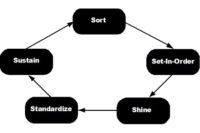Manufacturers vigorously seek out best practices because they can improve metrics, such as stock price, sales and profitability. There’s only one problem: Best practices are the actions that solved yesterday’s problems.
Best practices are often thought of as discrete tools or processes, but there’s a hierarchy to them. Up a level from the discrete tool is a methodology or a collection of processes, such as lean or Six Sigma. Up another level is a coordinated set of methodologies that makes up a framework—how a company goes about its business or an important initiative. There are best practices for all levels, and their place in the hierarchy is defined by the problems they solve.
Companies seek best practices for the right reason—to multiply the benefit of previous success. But they’re sometimes pursued like they’re ends unto themselves. Once deemed “best,” they can become gospel, scripted and unchangeable. But yesterday’s best practice is not tomorrow’s, and yesterday’s script is not right for today’s performance.
There are countless unique tools and processes, and each company has unique objectives, culture and problems. This variation makes every context unique, which makes every problem different. There can be no predestined best practice for a given problem, yet there is commonality that holds together best practices as a family.
All best practices are solutions in search of problems, and every problem has a context. Start with the problem and its context, and the ideal best practice will emerge. The right best practice is a result of the context (the situation we’re in, why we’re in it, and where we want to go) and the problem (what’s in the way). The latter comes in two flavors: “what we have isn’t good enough” (continuous improvement), and “we’re missing something” (discontinuous improvement or innovation).
Here are three scenarios for continuous improvement:
Profits are too low because manufacturing costs are too high. Likely best practice: Use lean to reduce wasted time.
Profits are too low because quality is poor. Likely best practice: Use Six Sigma to reduce process variation.
Profits are too low because product cost is too high. Likely best practice: Use design for assembly (DFA) to reduce material cost.
For each scenario, the destination is the same, but the context is different, so the best practice is different. How lean, Six Sigma or DFA are implemented is governed by the lower level context (where we want to go) and the specific problems. The first tools to be used emerge from the problems to be solved.
Here are two scenarios for discontinuous improvement:
Profits are too low because the product isn’t selling in developing markets. The price is too high. Likely best practice: Redesign the product to provide 80 percent of its original functionality at 20 percent of the cost.
Profits are too low because the product isn’t selling in developing markets. The product doesn’t do what the market needs. Likely best practice: Use indigenous engineering so the product does what it should.
Again, the destination is the same, but the context is different, so the best practice is different. Each implementation is governed by lower level context and problems: the breadth of product functionality, the wrong product functionality, high material costs, or the fact that the product won’t run on batteries.
Best is not universal and best is not static. Best is contextual. Best is best when it solves the problem; best is best when it meets company objectives.





